Quick search
CTRL+K
Quick search
CTRL+K

Kiev is the capital of Ukraine and one of Eastern Europe’s great and beautiful metropolitan cities, where there are distinguished sights from the last many centuries. Kiev’s more than 1,500-year history is reflected in the city’s many historic buildings, architecturally ranging from the Kiev-Russian style to the elegant Ukrainian Baroque to the Soviet style.
Of the buildings of Kiev, the many churches and monasteries stand as the main reason for visiting the city of the Dnieper, and with gilded domes also provide several unforgettable experiences, where the beautiful Christian facilities seem almost endless in Kiev’s beautiful skyline.
The overall impression of the architecture of the church complexes is the Ukrainian Baroque, which, among other things, Bartolomeo Rastrelli contributed to St. Andrew’s Church, which is one of the city’s landmarks. From later times the great Soviet Soviet architects of the mid-1900s also distinguished themselves. Buildings from this era stand as monuments of the ability of communism in the Soviet Union.
Kiev, with its three million inhabitants, is also one of Europe’s major cities. At the same time, the city is very green and almost rural in its places. The wide river Dnieper cuts through the city, and in its course there are several islands with fine sandy beaches a short stroll from the city center.
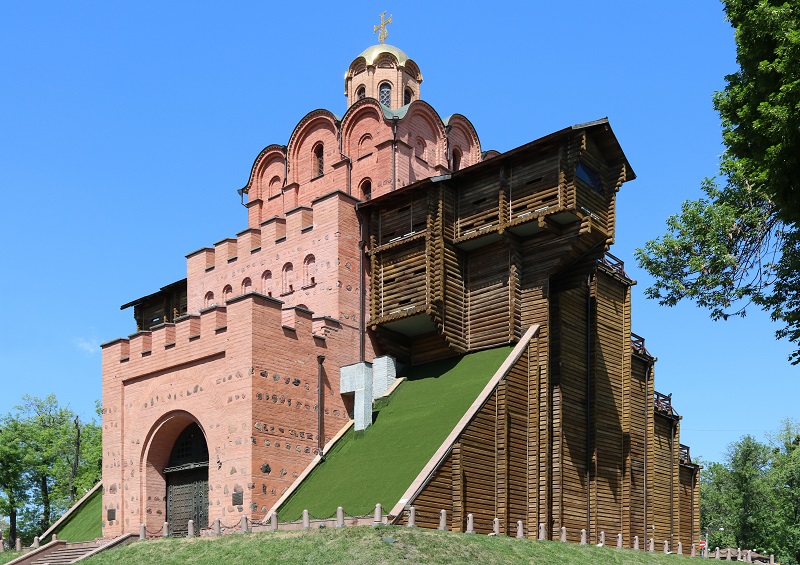
Golden Gate is a building that was built in the years 1017-1024 as the fashionable entrance gate to Kiev. It was Prince Yaroslav I the Wise of Kiev who wanted to show that the city and the country were not left behind for Constantinople.
The gate is built on the spot where Prince Jaroslav won the decisive battle over the nomads of the area. He had prayed for a victory and therefore built a church on top of the great gate building as thanks for the victory.
The Golden Gate was the city’s main entrance until the 18th century, after which it fell into disrepair. During the 20th century, the large gate was reconstructed and reopened in 1982. In the church at the gate, you can see interesting frescoes and paintings.
As a neighboring building to the imposing neoclassical Ukrainian parliament is Italian Bartolomeo Rastrelli’s elegant baroque palace Mariinsky. Rastrelli is famous for his distinguished and colossal 18th-century buildings in St. Petersburg, Russia, and Kiev’s Mariinsky carries Rastrelli’s distinct design features.
The Mariinsky Palace was built 1744-1752 as the residence of the Tsar family during visits to Kiev. It was Tsarina Elisaveta Petrovna who initiated the construction, but she did not get to experience the beautiful palace herself. It was instead Catherine the Great, who in 1787 became the first regent to live at the Mariinsky Palace.
The place later became the seat of the Russian governors-general until it burned down in the early 1800s. In 1870, Tsar Alexander II had the palace rebuilt according to original drawings and color sketches. He also named the place Mariinsky after his wife; Tsarina Maria Alexandrovna.
The palace played a role as the seat of the Provisional Government in the years following the Russian Revolution. From 1917 to 1920, the so-called Revolutionary Committee was based in the Mariinsky Palace; among other things in connection with the Bolshevik uprising in the days from 8 to 13 November 1917.
Today, the palace is used for Ukraine’s receptions of heads of state and other official guests in the city. The Kyiv History Museum sometimes organizes tours of the Mariinsky Palace, which, as the official ceremonial presidential residence, is usually closed to visitors.
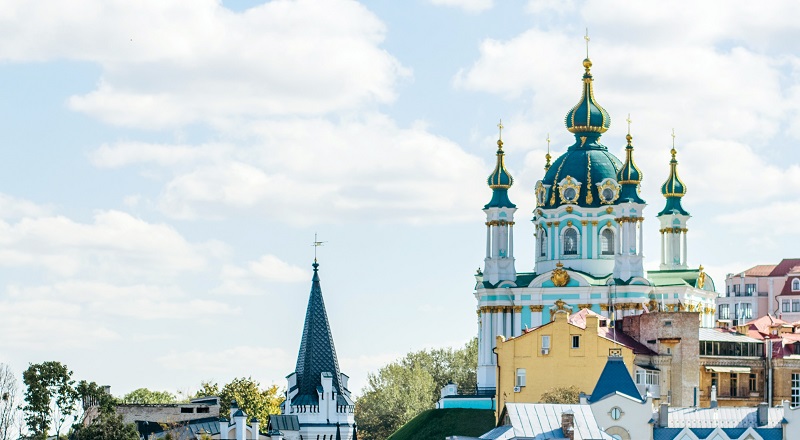
The beautiful Saint Andrew’s Church is one of Kiev’s architectural highlights and stands as one of the city’s landmarks. The beautiful building stands on Andreevskij Spusk street, which connects the center of Kiev in the most pleasant way with the Podol district and the Dnieper river. Literally, the church dominates the area and is a must-see during a visit to Kiev.
Saint Andrew’s Church was built in the years 1747-1754 under the design of Italian Bartolomeo Rastrelli, who is not least famous for his fantastic palaces in Russian Saint Petersburg. The style is baroque
The church is named after the disciple Andrew, who should have come to Kiev in the first century after the birth of Christ. He erected a cross on the very spot where St. Andrew’s Church was later built, and the disciple predicted at the time that a great city would arise in the area.
In 1086, the Grand Duke of Kiev erected a wooden church in memory of Andrew’s cross, and it stood up to the ravages of the Mongol armies in 1240. In 1690, another wooden church was moved here from Podol, but this was torn down again in 1725. After that, the current church built.
It was Tsarina Elisabeth who initiated the construction. She ruled Russia from 1741 to 1762, and she had decided to have a summer residence built in Kiev. It became the Mariinsky Palace, and a church was to be built for this, which became St. Andrew’s Church. Since Elisabeth herself wanted to keep the church, it did not become a parish church, and for the same reason it was not necessary to build a church tower.
The exterior of the church is particularly beautiful and in Bartolomeo Rastrelli’s well-known style. The interior is also very interesting; you can see, among other things, the church’s elegant iconostasis, which was also designed by Rastrelli, but prepared by Russian Alexei Antropov and others. Several Ukrainian 18th-century masters decorated the church with frescoes, while Alexei Antropov and Ivan Vishnjakov painted the icons in the church space.
Sofia Cathedral belongs to Kiev’s absolute top sights with its history and architectural beauty. Together with Kiev’s Petersky Monastery, the cathedral is also included in UNESCO’s list of world cultural heritage.
The cathedral is believed to have been founded and built from the year 1011 under Prince Jaroslav the Great; however, certain sources indicate that it happened in the year 1037 during the reign of Jaroslav I the Wise. The church building was built as the social, political and cultural center of the state of Kievan Rus, and thus the facility was both important and a kind of status symbol from the power of the rulers and the nation.
The name Sofia Cathedral comes from the church of Hagia Sofia in Constantinople, whose name refers to the holy wisdom, which is also the case with its namesake in Kiev.
You can still see preserved wall paintings from the 11th century, but in general there have been quite a few structural changes to the cathedral throughout its long history. In 1169 Vladimir-Suzdal’s troops attacked, and the Mongols ravaged the city in 1240; on both occasions the church was partially destroyed. In the 16th century, the building also suffered major damage, but each time it has been restored and partially rebuilt.
The cathedral burned down in 1697, and in 1707 Tsar Peter I had it rebuilt in the current beautiful Ukrainian-Baroque style with the beautiful gilded cross spiers. It was also on this occasion that the distinctive and free-standing bell tower was erected; it happened in the years 1699-1707.
After the communist takeover with the Soviet Union, it was planned to demolish Sofia Cathedral in favor of a heroes’ park commemorating the Red Army’s victories in Crimea during the revolutionary years. However, the plans were not carried out, and instead the authorities turned the cathedral into a museum from 1934; this status the place has continued.
Sofia Cathedral was also erected as a funeral church for the princes of Kiev; among others for Jaroslav I the Wise. Inside you can see the Byzantine mosaics from the foundation of the church as well as frescoes on the walls, pillars and in the crypt. In the tower there are 11th-century paintings depicting scenes from Constantinople.
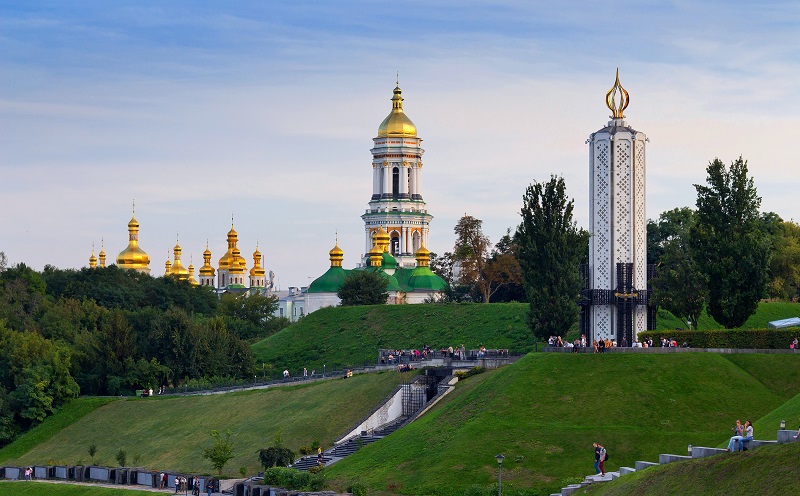
Kiev Pechersk Monastery is perhaps the most famous and impressive of Kiev’s many religious buildings. Also known as the Cave Monastery, it is among the structures in the Ukrainian capital that have been included in the UNESCO World Heritage List.
The monastery was founded in 1051, when monks settled in the caves by the Dnieper River. Over time, their establishment was expanded into the magnificent and large monastery complex that you can experience today. Here there are both churches and cathedrals, bell towers, defenses and caves, which the monks originally settled in. It’s almost just about exploring.
The monastery’s activities have played a significant role in the cultural development of the early Russian area, and in this way the Kiev Pechersk Monastery plays a large symbolic role in the Orthodox Church.
Coming from the streets of Kiev, one first encounters the Gate Church of the Trinity/Троицкая Надвратная церковка/Троїцкая Надбрамна церкова, built in its original Kievan Rus’ style in 1106-1108. The church was located on top of the main entrance to the monastery, which was surrounded by fortifications. Today, the church stands in Ukrainian Baroque from the 18th century with, among other things, many and very beautiful wall paintings.
After the entrance you come to the Great Monastery Bell Tower/Большая Лаврская колокольня/Велика Лаврська дзвиниця, which is one of the dominant buildings of both the monastery and Kiev. The tower was built in the years 1731-1745 according to the design of Johann Gottfried Schädel, and it has a height of 96.5 meters. The tower has four floors with a diameter of almost 29 meters at the base and a gilded dome at the top. In the tower there is a viewing platform that gives a unique look over the monastery and Kiev.
After the bell tower is Mary Ascension Cathedral/Успенский собор, which is the central church of the monastery. It was originally built in Kievan Rus in 1073 in the Byzantine style. Today, however, the large church stands in elegant baroque from the 18th century. During World War II, the Germans blew up the church, which then fell into ruins. In the years 1998-2000 it was rebuilt in its baroque style. The church’s many golden domes are some of the things that draw the monastery’s skyline when seen from a distance.
Immediately next to the cathedral is the refectory church Trapeznyj Khram/Трапезный храм/Трапезна церква, which stands out with its large Byzantine dome. The refectory is located in a part of the building, while the church dedicated to Saint Anthony and Theodosius is located in the part of the building under the dome. The building was constructed in 1893-1895, and at this time there were over a thousand monks in the monastery, whereby a new refectory had become necessary.
North of the Ascension Cathedral is the Church of the Holy Trinity/Церковь Всех Святых/Церква всих святих. The church was built in 1696-1698 in the Ukrainian Baroque style and features five gilded domes with a beautiful interior underneath. This applies, for example, to the iconostasis and the walls, which are elegantly decorated and painted. This church completes the most important buildings in the so-called upper monastery.
The lower cloister is southeast of the upper cloister. The closest area forms the monastery’s garden, where the monks actively cultivated the land. To the southeast of the garden are several monastic buildings, and the Church of the Holy Cross/Крестовоздвиженская церков/Хрестовоздвиженская церкова is one of the first ones you meet. It was built in 1700 and remains largely original from that time. From the church is the historic access to the nearby caves.
Access to the more distant caves is further to the southeast through Annozachatievskaya Church/Аннозачатиевская церковка/Аннозачатіївська церкова. The church was built in 1679 with an entrance to the area’s caves from the church itself.
Next to it is the Church of the Nativity of the Virgin Mary/Церковь Рождества Пресвятой Богородицы/Церква Риздва Пресвятой Богородици, which was built in 1696. At the church you can see this part of the monastery’s bell tower, which is 41 meters high. The tower was built in 1761 and is beautifully decorated with its gilded roof structure. The tower is called the Bell Tower of the Far Caves/Колокольня на Дальних печерах/Дзвиница на Дальних печерах and ends the tour of the monastery.
Saint Michael’s Monastery is one of the most beautiful and best-known of Kiev’s many distinguished church and monastery buildings. It is close to Sofia Cathedral and St. Andrew’s Church, which are other of these fine facilities.
The monastery is a building complex consisting of several individual parts, with the Bell Tower/Колокольня/Дзвиница being the common access road. The large tower was built in the years 1716-1719, which was approximately 600 years after the foundation of the monastery.
It was Sviatopolk II who had the monastery built from the year 1108, and he dedicated it to Archangel Michael, who was Sviatopolk’s patron saint. The church of the monastery was certainly the first in Kiev to have a gilded dome, and it initially stood as a burial church for Sviatopolk’s family.
With the Mongol invasion in 1240, the monastery was destroyed and the church’s gilding was stolen. The site then fell into disrepair until the late 15th century, when its renaissance began. In the following century, the monastery became one of the richest in Kiev and the Ukrainian territory. Over time, the monastery was expanded with new buildings; eg the bell tower.
Behind the tower you can see Saint Michael’s Cathedral/Михайловский Златоверхий собор/Михайлівський Золотоверхий собор, which is the central and dominant building and the one that started the tradition of Kiev’s many gilded domes.
The cathedral stood as a Byzantine-inspired church with a single dome until the beginning of the 18th century. After this, a large-scale reconstruction to the popular Ukrainian Baroque of the day began, and in the 1740s the church stood in its new external design, which had, among other things, given six new domes around the old one. The interior of the church was basically still Byzantine, although decorations with stucco and a large icon wall were some of the things that changed the church space.
Immediately south-east of the cathedral is the Refectory of John the Baptist/Храм Иоана Богослова, which is a beautiful simple building from 1713. The building was erected as a dining hall etc. for the monastery’s monks.
In the summer of 1934, the Soviet authorities started a demolition of the entire monastery in favor of a planned, but not completed, construction of a new Ukrainian government center. Specialists moved the cathedral’s Byzantine mosaics before the remains of it and the bell tower were blown away in 1936. A sports facility was later built on the site and the monastery’s refectory was used as a changing room.
In the 1970s, the Soviet Union drew up plans for the reconstruction of the entire monastery, but construction did not begin until 1997. The site was consecrated in 1999, and today you can see the beautiful facility with original mosaics reinstated in the interior of the cathedral.
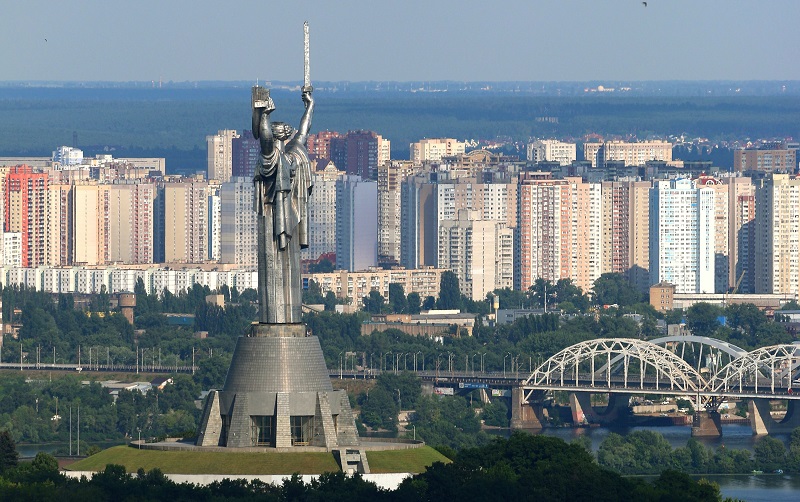
In the area for the memory of the battles against the Germans during World War II, you can see the impressive monument to the motherland; the Rodina-Mat statue.
The Motherland Monument is a statue 62 meters high, which together with its building foundation reaches a height of 102 meters. The statue is made of steel and weighs 560 tons, and the 16-meter-long sword alone weighs 9 tons. In the opposite hand of the sword, the motherland figure holds a shield, on which until 2023 you could see the symbol of the Soviet Union, which fought the war against Germany.
In 2015, Ukraine banned symbols of the Soviet Union and the communist era in the country, but as a monument to World War II, the law did not apply to Rodina-Mat. However, they chose to replace the symbol anyway in 2023.
On the site of the statue, there were plans in the 1950s for twin statues of state leaders Lenin and Stalin; both had to be over 200 meters high. These plans did not materialize and instead a statue of the Soviet Motherland was decided upon. Construction began in 1979, and the statue was inaugurated along with the rest of the facility by Leonid Brezhnev in 1981.
Today, the Motherland Monument stands as one of Kiev’s most impressive buildings and also as one of the most monumental monuments in the former Soviet Union. You can see the statue from a long distance, and Rodina-Mat is particularly impressive when you visit the place.
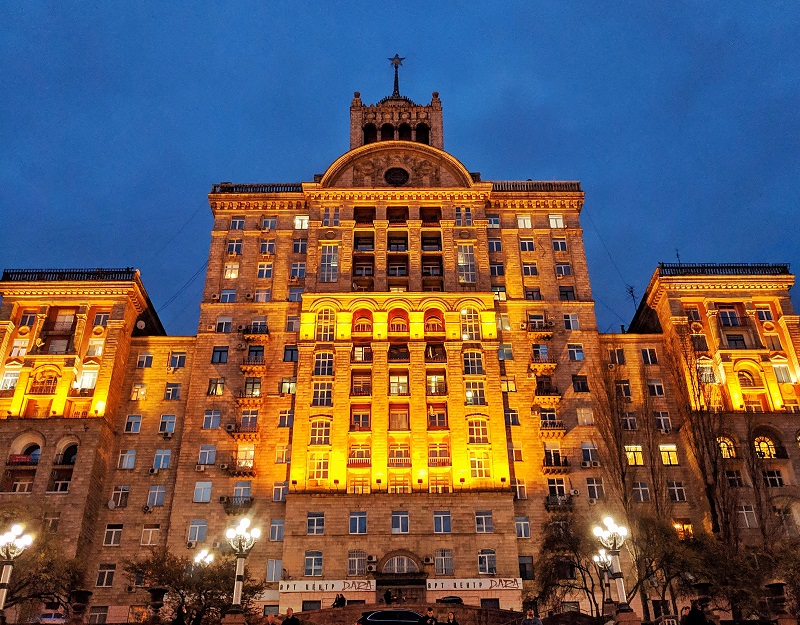
Kreschatik is Kiev’s fashionable and splendid street, which with its chestnut avenues was laid out just before the year 1800. The street’s name takes its origin from the Slavic word for cross, which is due to the fact that the landscape was originally shaped as such precisely here, where the street lay in a valley depression.
The current shape of the street itself dates from 1837. The many fashionable buildings that sprang up here from the 19th century and at the beginning of the 20th century were all destroyed during World War II in an operation that entered the military history books. The Red Army had placed bombs in the buildings, and after the German occupation from September 1941, the Soviet forces blew up the houses radio-controlled from a distance of over 400 kilometers from Kiev.
Incidentally, the trams stopped running along Kreschatik until the war; the first electric tram line was established in the Russian Empire was laid in Kiev in 1892, and in 1894 it reached Kreschatik.
After World War II, Kreschatik was rebuilt in the present harmonious and imposing style during the Soviet era. The architecture clearly bears the stamp of the Stalinist building style that characterized larger constructions not least in the 1950s. Among the buildings typical of the period is Kiev City Council/Киевский городской совет/Київська миска рада (Kreschatik 36) from the 1950s.
Kiev Metro is a transport system, but for certain parts of the facility also an attraction, showing the construction of Soviet subways as a kind of people’s palaces.
The metro was built as the third in the Soviet Union after Moscow and the track in what was then Leningrad, today called Saint Petersburg. There were already plans in 1916 that would have made Kiev the first city in the Russian Empire to have a subway, but these did not materialize.
With the Soviet Union, Kiev’s role was minimized, and until the city’s status as the Ukrainian capital in 1934, no major construction plans emerged. After 1934, the city was rapidly expanded, and again there were plans for a subway. World War 2 got in the way, and the metro was built instead from 1949, with the opening of the first section in 1960.
Today, the metro has three lines, laid out with a central triangle with crossings of all lines; this was the typical Soviet subway design. The five oldest stations are the most interesting, and they are located from Vokzalnaja/Вокзальная/Вокзальна to Dnepr/Днепр/Днипро on line 1.
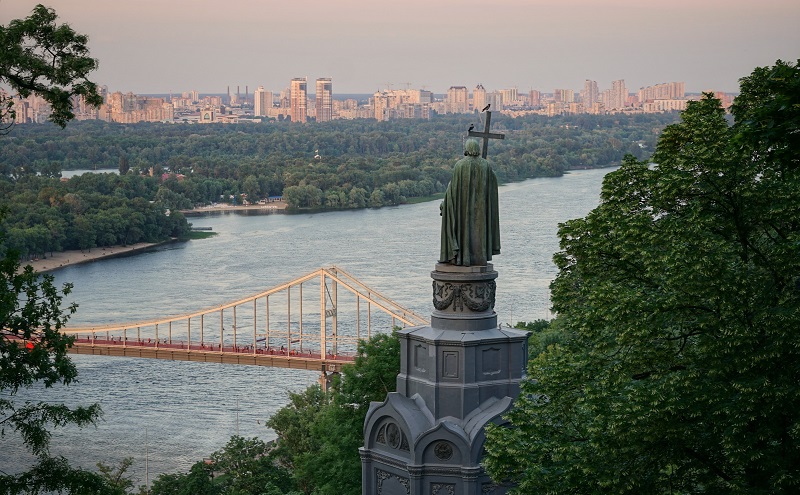
This park area along the Dnieper River was laid out in the late 19th century as the starting point for the annual religious celebration on St. Vladimir’s Day, and since then many great Ukrainian artists have found inspiration in the park.
In the western part of the large green area, you can see a monument to Prince Vladimir, Pamjatnik Svjatomu Vladimiru/Памятник Святому Владимиру, who in 988 Christianized Russia. The 4.5 meter high statue was cast in Saint Petersburg and erected in 1853.
However, the most significant monument in the park has for many years been the People’s Friendship Arch/Арка Дружбы народов, erected in 1982 to celebrate the reunification of Russia and Ukraine in the Soviet Union, the first 60 years of the union and the 1,500th anniversary of the city of Kiev. The arch has a diameter of 50 meters and was produced in titanium.
The Friendship Arch has been called several things over time. At its opening, it was officially called the Memorial Monument for the Reunification of Ukraine with Russia, before it was renamed the People’s Friendship Arch. In 2022, it changed its name again to the Arch for the Freedom of the Ukrainian People. At the arch, in the years 1982-2022, a statue of Russian and Ukrainian workers could be seen, and there is also a stele illustrating the Perejaslav Council from 1654.
The Bessarabian Market is a market building named after the Bessarabian (Moldavian) merchants who originally brought their goods to Kiev and sold them in this place. It is an indoor market in a fine market hall that was built 1910-1912.
Opposite the market, until December 2013, stood a statue of the Soviet leader Vladimir Lenin. It was unveiled in its time by Nikita Khrushchev, and the statue was the last of Lenin in central Kiev.
This museum was founded in 1919 on the basis of the private collection of the Khanenko family. Today it has Ukraine’s finest collection of foreign art, and in the Soviet Union it was among the leaders of its kind.
The museum building, whose collection contains 17,000 objects, was built in the neo-renaissance style in the 1880s by the architect Meltzer from Saint Petersburg. The builders were Bogdan and Varvara Khanenko. The couple’s art collection was built up through purchases at a number of European auctions, and after Bogdan’s death in 1918, Varvara donated the collection to the state.
Here you can see ancient Greek and Roman art as well as works by, among others, Flemish, Spanish, French, Italian and Dutch painters. In addition, there are collections from Egypt and various countries and cultures in Asia. There are also Byzantine icons and much else to experience.
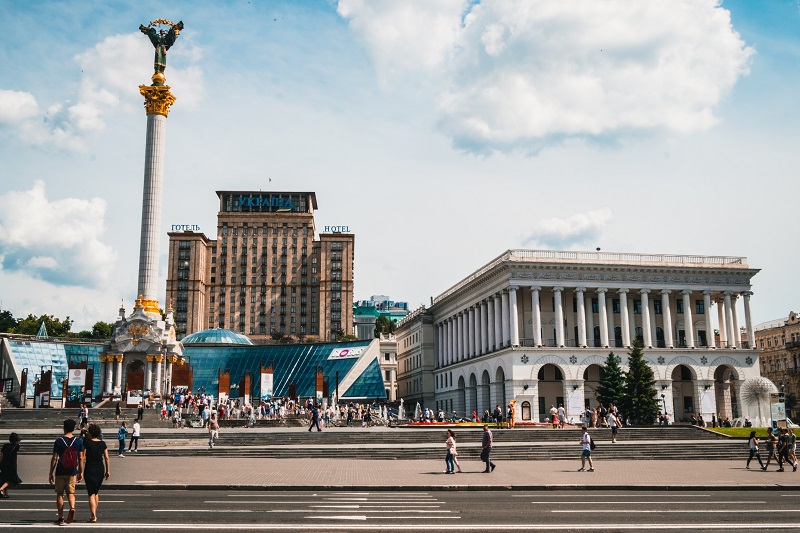
Independence Square is, so to speak, the center of Kiev and thus probably the most well-known and important square in Ukraine. The square is located on the continuous main street in central Kiev, Kreschatik, and concerts, parades, etc. are held on it. A trip here is almost impossible to avoid on a trip to the Ukrainian capital.
In the square there are six fountains, an artificial waterfall and the tall column Independence Monument/Монумент Незаженийсти/Монумент Незалеженности. At the top of the column you can see the archangel Michael, who is the patron saint of Kiev. From the high level of the square there is a beautiful view of the entire area and much of the Kyiv skyline.
Before destruction around the square during World War II, a statue of the Archangel Michael could be seen atop the elegant and now defunct Kiev Duma/Киевская городская дума/Київська миска дума. The Duma was the seat of the Kyiv City Council, and Independence Square was temporarily called Duma Square/Думская площадь; throughout a longer part of Soviet history it was named after the head of state Mikhail Kalinin.
Today you can see other fine buildings. The monumental Hotel Ukraine/Гостиница Украина/Готель Україна (ul. Institutskaja 4/Ул. Инститтуская 4/Вул. Институтська 4) to the southeast is a fine example of grandiose Soviet architecture and urban planning. The hotel is located on the very site where Kiev’s first skyscraper, Ginzberg Skyscraper/Небоскрёб Гинзбурга/Хмарочос Гінзбурга, stood from the start of construction in 1910 until the destruction of World War II.
In front of Hotel Ukraine you can see a modern glass facade with a glass dome on top. It is the shopping center Globus/Глобус, located here on the attractive square in the heart of Kiev.
On opposite sides of Hotel Ukraine and Globus are respectively the October Palace/Октябрьский дворец/Жовтневий палац (ul. Institutskaja 1/Ул. Инститтуская 1/Вул. Инститтутская 1) and the National Music Academy/Национальная музыкальная академия (ul. Arkhitektora Gorodetskogo 1/Улица Архитектора Городецкого 1/вул. Архитектора Городецкого 1), which is named after the Russian composer Tchaikovsky. The academy is architecturally dominated by arches on the ground floor with a columned facade above the entrances. It was established in 1913 and is located in a building from the 1880s that was originally built as Hotel Kontinental.
The October Palace was built 1838-1842, and until the Russian Revolution in 1917 an educational institution for young women was located here. After the revolution, the place was converted into government offices, and among other things there was also an office for the local Cheka, which later became known as the KGB. Today, the place is a cultural center with a concert hall and more.
In the square you can also see a smaller gate building. It is Ljadsk Port/Лядские ворота/Лядские ворота, which was rebuilt in 2001 after one of Kiev’s old city gates, which was located elsewhere in the city. At the top of the gate is a statue of the Archangel Michael.
The gate stands to the north-west of the square and immediately in front of a glass dome like the one at the Hotel Ukraine. The dome is the opposite end of the center Globus, which extends under the entire Independence Square. The north-western part of the square is surrounded by imposing and appropriately symmetrical buildings; mainly in Soviet classicism of the Stalin era style in the early 1950s.
Two colossal buildings dominate to the north and south of this part of the square, and between them lie five smaller buildings in the same style in a semi-arch. Of the large buildings, you can see the Kiev Main Post Office/Киевский Главпочтамт/Київський Головпочтамт to the south and the newer Trade Union Building/Дом профсоюзов Украины/Будинок профспилок Украины to the north.
The trade union building was built between 1976 and 1980, and the building is characterized by the 24 meter high tower, which is adorned with a clock. Originally, this building was to be identical in style to the post office building opposite, which was built in the years 1952-1957. The first stone house of street Khreshchatik used to be located on the grounds of the post office; it was built in 1797 and renovated after World War II.
In recent decades, Independence Square has been the gathering place for various demonstrations, and it was the place where larger demonstrations came to be written into the country’s history as the hotbed of the unrest that started around the turn of the year 2013/2014.
Founded in 1867, this theater is Ukraine’s oldest musical theater. The current theater building was built by Victor Shreter, who was an architect from Saint Petersburg. The style is elegant Neo-Renaissance, and construction began in 1896, when a former theater burned down. The building and thus the theater was inaugurated in 1901. The theater was restored in the 1980s, and the beautiful interior is both original and very well maintained.
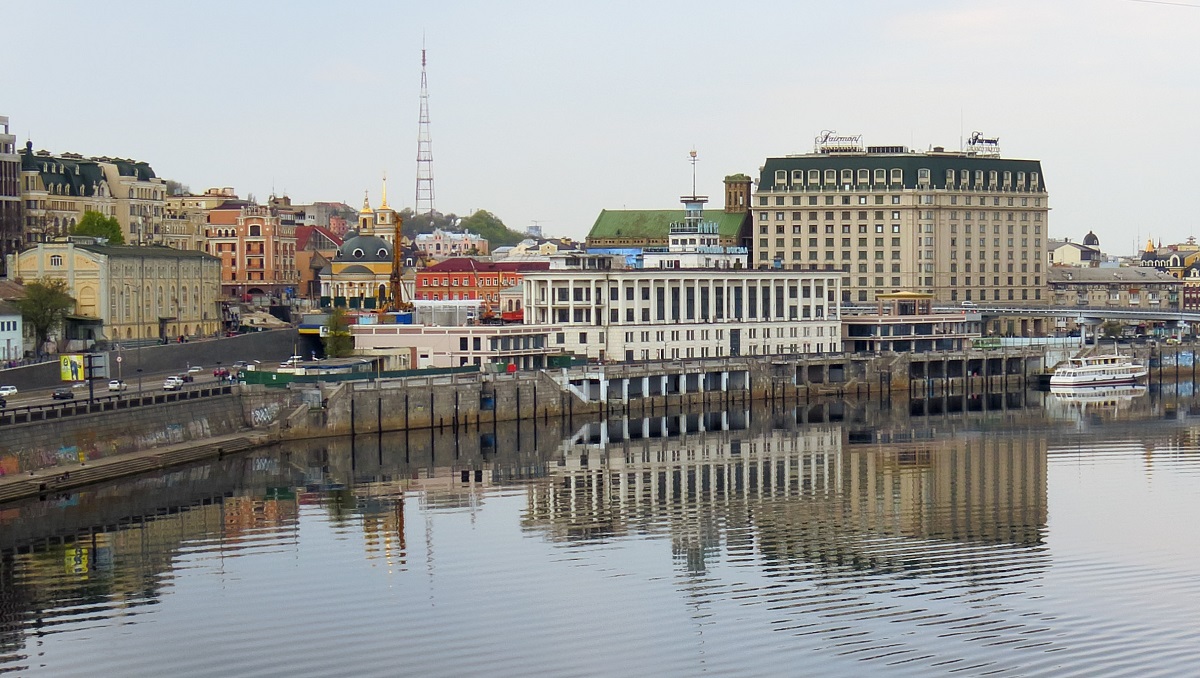
Post Square is a square on the river Dnieper and it is one of the oldest squares in the Ukrainian capital; effects dating back to the 300s have been found during excavations. The square is named after the district of Podol’s post office, which was opened here in 1846. The post office is still located here, but it is no longer used as a post office; it is now set up as a gallery.
Immediately southeast of the old post office you can see the Church of the Nativity of Christ The beautiful church was built in 2003 after the design of the original church on the site, which was built 1810-1814 by A. Mellenski. This church had been demolished in the 1930s.
The square is located on the Dnieper River and the Kyiv River Station, where cruise ships call at the city. The building can look north-east on the square.
This is a memorial park laid out on the green slopes between the center of Kiev and the Dnieper River. It is a large landscaped park from Ukraine’s Soviet era, and there are several sights and monuments in it.
Historically, the park was a kind of garden facility that grew into a regular park. It was in 1956 that the Soviet authorities decided to establish the area as a memorial to the many fallen during the Great Patriotic War, as World War II is called in Russia.
The park was laid out with an all for heroes who excelled during the battles; among others, twelve people who had the status of Heroes of the Soviet Union were laid to rest. An eternal flame for the unknown soldier was also established.
After Ukrainian independence in 1991, it was decided in 2007 to expand the park with a facility in memory of the Ukrainian famine known as the Holodomor, which cost the lives of several million people.
This is one of Kiev’s ancient monasteries, the site was founded in the 1070s by Vsevolod I of Kiev. Vsevolod’s son, Vladimir II, became the cause of the monastery’s name, which is due to an old tradition.
According to the story, Vladimir ordered figures of the pagan god of thunder Perun and other gods thrown into the river Dnieper. This caused some of the city’s inhabitants to walk along the river and pray to the gods for resurrection from the water; and this swimming up again gave its name to the neighborhood and to the monastery.
You come first to the monastery’s bell tower and then to the central St. George Church/Георгиевский собор/Георгиївський собор. This church with its fine domes and spires was built from 1696 until its completion in 1701, when the church was consecrated by the Metropolitan. Sankt Jørgen Church was characterized by an elegant baroque interior.
Among the monastery’s fine buildings, you will also find the monastery church St. Michael’s Church/Михайловский собор/Михайлівський собор further east. It was erected on the initiative of Vsevolod I, but changed significantly later. The current church is the result of a rebuilding in the years 1767-1769, which gave the fine structure a Ukrainian Baroque design.
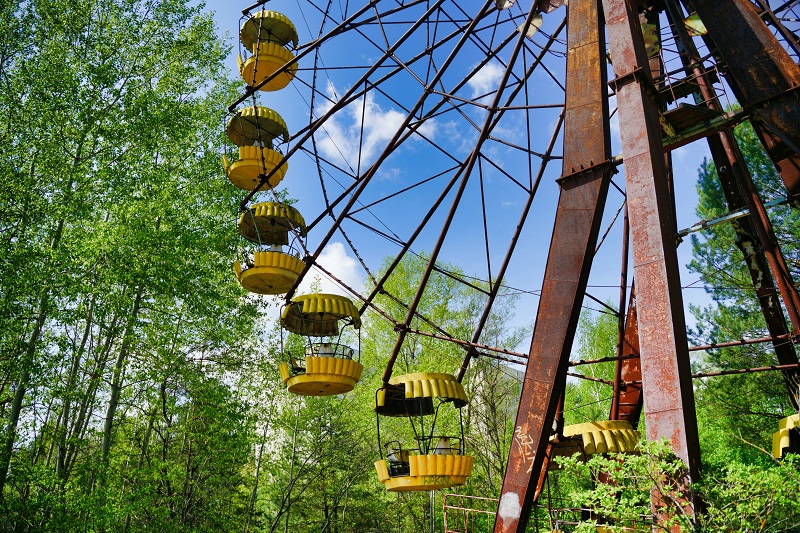
North of Kiev lies the Chernobyl nuclear power plant, where a colossal accident occurred on April 26, 1986. Subsequently, the exploded reactor core 4 was enclosed in a large concrete sarcophagus.
Tourist agencies in Kiev organize day trips from Kiev to the Chernobyl area, where you can see the nuclear power plant itself, as well as the abandoned city of Pripyat and other parts of the evacuated zone. Bookings must normally be made well in advance.
South of Kiev in the idyllic village of Pirogovo is the open-air museum of the architecture of the Ukrainian people. The museum was founded in the late 1960s and opened in 1976. Over the years, it has built up a large collection of beautiful buildings from the country’s history. More than 200 buildings come from all over Ukraine and have been reconstructed on the 15-hectare museum area. However, some buildings are reconstructions of earlier architecture.
Part of the purpose of the Open Air Museum is to depict life in the villages through time, and there are separate exhibitions for life here in previous centuries and during the Soviet Union’s national agricultural policy. At the museum, you can also see traditional handicrafts in the very large ethnographic exhibition, and traditional Ukrainian food is served in the restaurant.
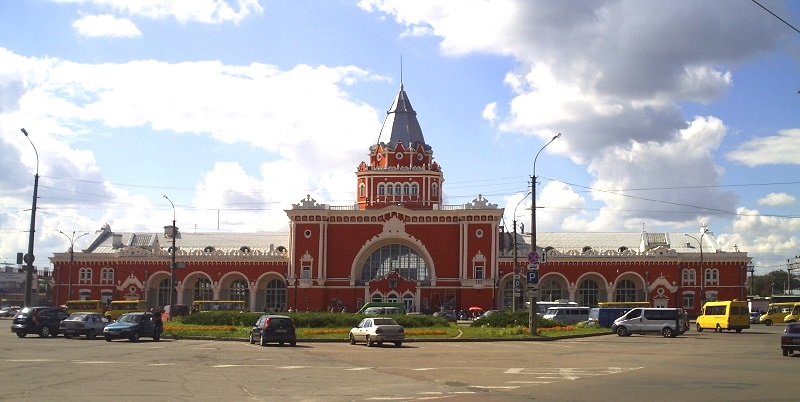
On the right bank of the Desna River lies the regional center Chernigov with its 300,000 inhabitants. Chernigov is one of Ukraine’s oldest cities, and already from the 9th century it was part of Kievan Rus. After the destruction of the city by the Tatars in 1239, it became part of the Grand Duchy of Lithuania until Moscow conquered the area in 1503.
Chernigov is a very green city, and it is particularly beautiful with the many gilded domes and towers on magnificent buildings from Russia’s past. There are many attractions, and they are mainly located in the old town.
In the city you can see the national historical and cultural monument, Dytynets, which is a fortification from the 12th century. You can also visit the Church of the Savior, which was built in 1030 at the beginning of the Christian Russian era and is the oldest preserved church in Ukraine. The style is Byzantine and the church has five domes.
Built in 1123, the Boris and Gleb Cathedral is a fine example of Kievan Rus’ architecture. The church is set up as a museum, where you can see many objects from the city’s past.
Chernigov College was established and built in 1700-1702 in the Ukrainian Baroque style and decorated with a variety of architectural details. The college was one of the area’s first secular higher education institutions.
Catherine’s Church was built by Chernigov colonel Jakov Lizogub in memory of the town’s Cossack heroes. The church dates from the 18th century and is a beautiful example of the Ukrainian Baroque style. In the area of the Desna river there are Cossack cannons from the time of the church.
The city’s old history and importance can also be seen in several monastery buildings. Both the Eletsko Monastery and the Trinity Monastery with the Antonius Caves were founded in the 11th century and were continuously expanded over the following many centuries.
The old town is worth a stroll. You can experience the beautiful secular architecture from the 17th-19th centuries at, among other things, Jakov Lizogub’s house, the archbishop’s house and the governor’s residence.
Kanev is one of Ukraine’s old towns, and on Kanev’s Tarasova mountain, the great Ukrainian poet and artist Tara Shevchenko is buried. The area is today a large memorial area; it was established as such in 1923.
The place has since been a place of pilgrimage for both the progressive intelligentsia and other visitors. In 1939, the monument to Shevchenko was erected, and the museum displays the artist’s history, works and a number of personal items.
In addition, Kanev is also home to hydroelectric power through works at the end of the 162 kilometer Kanev Reservoir/Каневское водохранилище/Канивске водохранилище, which is an up to 5 kilometer wide dam of the Dnieper River in the area south of Kiev.
Kreschatik/Крещатик
Independence Square/Майдан Независимости
ul. Bassejnaya/ул. Бассейная
pl. Bessarabskaya/пл. Бессарабска
Pl. Peremogi/Пл. Перемоги
Kreschatik/Крещатик, Independence Square/Майдан Независимости
Tsirk/Цирк
pl. Peremogi/пл. Перемоги
Gosudarstvennyj Muzej Aviatsii/Державний музей авіації/Государственный музей авиации
Medovaya 1/ул. Медовая 1
avia-museum.org.ua
Hidropark/Гидропарк
Trukhanov Ostrov/Труханов остров
Kievskij Gorodskoi Teatr Kukol/Киевский Городской театр кукол
ul. Miropolskaya 1/ул. Миропольская 1 & ul. Lunacharskogo 1b/ул. Луначарского 1b
Kievskiy Zoopark/Киевский зоопарк
Prospect Pobedy 32/пр. Победы 32
zoo.kiev.ua
Kievskij Planetariy/Київський планетарій/Киевский планетарий
Bolshaya Vasilkovskaya 57-3/ул. Большая Васильковская 57-3
planet.org.ua
Muzej Tramvayev/Музей трамваев
ul. Filatova/ул. Овилатова
mashke.org/kievtram/en/museum
Muzej Voskovykh Figur/Музей восковых фигур
ul. Khmelnitskogo/ул. Хмельницкого
Trukhanov Ostrov/Труханов остров
metropolitan.kiev.ua
uz.gov.ua
airport-borispol.kiev.ua
Kiev’s history started with the first settlements in the area in the 300-600s, and the city itself is believed to be founded in 482. Various peoples dominated the area on the Dnieper River until Scandinavians came sailing along the rivers and gathered the area under a regime.
The Scandinavians, who were called intoxicated, entered the Kiev area in 882 under Oleg from Novgorod. They made the place the city that over the next 200 years made Kiev the dominant political power of early Kiev-Russia, stretching between Volga, the Danube and the Baltic region.
Kiev-Russia’s great prince Vladimir I Christianized the country in 988. It came under the influence of Constantinople, and in fact, Christianity took place during a mass ceremony at the Dnieper, where the city was said to have converged to Christianity.
Christianity became the beginning of the political and cultural development that characterized the city in the following centuries, when part of the city’s churches and monasteries were established.
Kiev-Russia was divided at the beginning of the 12th century, and several states emerged. This included, among other things, Kiev as new principalities that existed in the period 1132-1471.
However, as early as the latter half of the 12th century, several cities were separated from Kiev, and the principality suffered a great defeat with the Mongols’ ravages and invasion in 1240. Great devastation meant that Kiev formally came under Vladimir-Suzdal. In 1362, Kiev was subjugated to the Grand Duchy of Lithuania, so the city was not independent through these centuries.
Kiev and the Ukrainian territory were hit by famine and military devastation, and by the 15th century a large part of the population perished. The void especially attracted some Cossacks who established a state around Kiev, though subject to Poland first and then Russia.
In 1569, Poland-Lithuania was formed, and on that occasion Kiev became subject to the Kingdom of Poland. It was a time when the Poles’ Catholic faith became the dominant one, thereby increasing Kiev’s religious status as the center of Orthodox faith during Poland. In the 1600s, this was strengthened with the metropolitan Peter Mogila, who renovated Kiev’s Orthodox churches and monasteries.
In 1648, Bogdan Khmelnytsky’s Cossacks entered Kiev and established the Cossack hetmanate. The Poles answered again, and the Cossacks sought support from the Russian czar against Poland. Russia was a rising power factor and came to dominate Kiev and the region for centuries to come.
In 1667, Kiev became Russian for a period of the Andrusovo Treaty. The treaty between Russia and Poland-Lithuania caused great territorial losses to the Polish-Lithuanian Empire. With a final peace in 1686, Kiev became Russian.
For the next centuries, Kiev and the Ukrainian territory were an integral part of the ever-expanding tsarist empire under the leadership of the Tsar in first Moscow and since 1703 Saint Petersburg. Russia’s expansion led, among other things, to the establishment of the present Ukrainian territory, where the Ottomans from Istanbul had been ruling along the Black Sea since the beginning of the 16th century.
The influence of the Baroque Kiev on the part of the Tsar and Russia on Kiev as part of the Russian Empire became clear both politically and culturally. Physically, this era came, among other things, to put architectural markings through the buildings of the Tsar and the Ukrainian Baroque, which is still seen in many places in the street scene.
Among the best-known works were the court architect Bartolomeo Rastrelli’s works in the city. Zarina Elisabeth wanted to build a residence in Kiev in the 18th century, and she built the Mariinsky Palace together with St. Andrew’s Church, which stands in magnificent baroque. This style is seen in great style in the then capital of St. Petersburg.
In the 19th century, increased Ukrainian nationalism occurred under the influence of cultural flourishing and the beginning of industrialization. This was especially expressed in cultural life, but Kiev’s general development also fueled the desire for increased self-government.
As in the rest of Russia, political tensions were on the rise in the early 1900s. The Russian Revolution of 1917 brought down the czarist rule of the centuries, and the communist Bolsheviks took power.
During the period of the Russian Revolution various political factions were formed, agitating for the formation of an independent Ukraine. However, none of the groupings achieved the support that could make the case national.
Instead, civil war erupted here too, with many different military units fighting each other and alternately occupying the city’s power bases.
After fierce fighting, which also involved Soviet forces, Polish and various ethnic Ukrainian population groups, the western regions of Ukraine joined Poland. The rest, including Kiev, became part of the Soviet Union in 1922.
During the Soviet Union, Kharkov was designated as the Ukrainian capital. Kharkov was a major industrial city whose materiality was increased at the expense of Kiev’s in those years. However, Kiev was also an industrial city in development, and in 1934 the city became a new capital instead of Kharkov.
With its status as the capital, Kiev’s was to be expanded with many new administration buildings, and large-scale Soviet buildings were either planned or realized in many places in the city. At the same time, the authorities demolished many churches and monasteries; partly to give way to government buildings.
In the 1930s, Kiev and Ukraine were also hit by great famines that cost millions of lives. It was also a time when Bolsheviks cracked down on nationalism that did not have to precede the Union’s best.
During the Great Patriotic War, called World War II in Russia, much of Kiev was destroyed during Germany’s 72-day attack and siege, with the city’s population and the Soviet army defending themselves in fierce fighting.
In November 1943, the Red Army overcame the Germans. A total of about 200,000 people were killed in Kiev and a total of 6 million Ukrainians during the fighting against the German armies.
After World War II, Kiev was rebuilt. The central Kreschatik boulevard was totally destroyed, and today’s postwar great Soviet architecture is seen here. Many old buildings were lost, but it gave way to new buildings and many new inhabitants.
Large new residential and industrial areas were erected and the city grew. Construction of a large public transport system was initiated. The first metro line was started in 1949 and opened in 1960.
Over the last few years during the Soviet Union, Ukraine was affected by the major accident at the Chernobyl nuclear power plant. It cost human lives as well as an evacuation of the areas north of Chernobyl, including the city of Pripjat close to the Belarusian border.
At the dissolution of the Soviet Union in 1991, Ukraine declared independence and elections were held for the new presidential office in the capital of the new state. Thus, Kiev became the capital of an independent Ukraine, and today it is Ukraine’s largest city, political center of power and at the same time the country’s cultural and economic center.
In 2012, Kiev was the world’s focus as the venue for the finals of the European Football Championships, held that year in Poland and Ukraine. The following years, it was quite different events that brought Kiev into the world’s media; from November 2013 to early 2014, there were demonstrations at Kiev Independence Square. In the wake of the demonstrations, Ukraine gained a new president and the Crimea Peninsula was reunited with Russia.
Today, the demonstrations are no longer like 2013-2014, and Kiev’s many stunning buildings stand in the beautiful areas of the river Dnieper and take visitors.
Overview of Kiev
The Ukrainian capital of Kiev is one of Eastern Europe’s great and beautiful metropolitan cities, where there are distinguished sights from the last many centuries. The city’s more than 1,500-year history is reflected in the city’s many historic buildings, ranging architecturally from the Kiev-Russian style to the elegant Ukrainian Baroque to the Soviet style.
Of the city’s buildings, the many churches and monasteries stand as the main reason for visiting the city at Dnieper, and with gilded domes also provide several unforgettable experiences, where the beautiful Christian facilities seem almost endless in the city’s beautiful skyline.
About the travel guide to Kiev
Number of trips: 5 tours in the city + tours in the surrounding
Pages: 45
Published: 2019
Author: Stig Albeck
Publisher: Vamados.dk
Languages: Danish
ISBN: 978-87-93329-85-0
About the travel guide The
Kiev travel guide gives you an overview of the sights and experiences of the Ukrainian city. Read about top sights and other sights, and buy a travel guide with tour suggestions and descriptions of all the city’s major churches, monuments, mansions, museums, etc.
Kiev is waiting for you, and at vamados.com you can also find cheap flights and great deals on hotels for your trip. You just select your travel dates and then you get flight and accommodation suggestions in and around the city.
Read more about Kiev and Ukraine
Buy the travel guide
Click the “Put in cart” button to buy the travel guide. You will then be taken to the payment, where you enter the purchase and payment information. After completing the wizard payment, you will immediately receive a receipt with a link to download your purchase. You can download the wizard immediately or use the download link in the email later.
Use the travel guide
When you buy the travel guide to Kiev, you get the book online so you can have it on your phone, tablet or computer – and of course you can choose to print it. Use the maps and tour suggestions and you will have a good and content-rich journey.
Golden Gate • Beautiful Churches • Monasteries • Dniepr • Mariinsky Palace
Overview of Kiev
The Ukrainian capital of Kiev is one of Eastern Europe’s great and beautiful metropolitan cities, where there are distinguished sights from the last many centuries. The city’s more than 1,500-year history is reflected in the city’s many historic buildings, ranging architecturally from the Kiev-Russian style to the elegant Ukrainian Baroque to the Soviet style.
Of the city’s buildings, the many churches and monasteries stand as the main reason for visiting the city at Dnieper, and with gilded domes also provide several unforgettable experiences, where the beautiful Christian facilities seem almost endless in the city’s beautiful skyline.
About the travel guide to Kiev
Number of trips: 5 tours in the city + tours in the surrounding
Pages: 45
Published: 2019
Author: Stig Albeck
Publisher: Vamados.dk
Languages: Danish
ISBN: 978-87-93329-85-0
About the travel guide The
Kiev travel guide gives you an overview of the sights and experiences of the Ukrainian city. Read about top sights and other sights, and buy a travel guide with tour suggestions and descriptions of all the city’s major churches, monuments, mansions, museums, etc.
Kiev is waiting for you, and at vamados.com you can also find cheap flights and great deals on hotels for your trip. You just select your travel dates and then you get flight and accommodation suggestions in and around the city.
Read more about Kiev and Ukraine
Buy the travel guide
Click the “Put in cart” button to buy the travel guide. You will then be taken to the payment, where you enter the purchase and payment information. After completing the wizard payment, you will immediately receive a receipt with a link to download your purchase. You can download the wizard immediately or use the download link in the email later.
Use the travel guide
When you buy the travel guide to Kiev, you get the book online so you can have it on your phone, tablet or computer – and of course you can choose to print it. Use the maps and tour suggestions and you will have a good and content-rich journey.


Kreschatik is Kiev’s fashionable and splendid street, which with its chestnut avenues was laid out just before the year 1800. The street’s name takes its origin from the Slavic word for cross, which is due to the fact that the landscape was originally shaped as such precisely here, where the street lay in a valley depression.
The current shape of the street itself dates from 1837. The many fashionable buildings that sprang up here from the 19th century and at the beginning of the 20th century were all destroyed during World War II in an operation that entered the military history books. The Red Army had placed bombs in the buildings, and after the German occupation from September 1941, the Soviet forces blew up the houses radio-controlled from a distance of over 400 kilometers from Kiev.
Incidentally, the trams stopped running along Kreschatik until the war; the first electric tram line was established in the Russian Empire was laid in Kiev in 1892, and in 1894 it reached Kreschatik.
After World War II, Kreschatik was rebuilt in the present harmonious and imposing style during the Soviet era. The architecture clearly bears the stamp of the Stalinist building style that characterized larger constructions not least in the 1950s. Among the buildings typical of the period is Kiev City Council/Киевский городской совет/Київська миска рада (Kreschatik 36) from the 1950s.
Kiev Metro is a transport system, but for certain parts of the facility also an attraction, showing the construction of Soviet subways as a kind of people’s palaces.
The metro was built as the third in the Soviet Union after Moscow and the track in what was then Leningrad, today called Saint Petersburg. There were already plans in 1916 that would have made Kiev the first city in the Russian Empire to have a subway, but these did not materialize.
With the Soviet Union, Kiev’s role was minimized, and until the city’s status as the Ukrainian capital in 1934, no major construction plans emerged. After 1934, the city was rapidly expanded, and again there were plans for a subway. World War 2 got in the way, and the metro was built instead from 1949, with the opening of the first section in 1960.
Today, the metro has three lines, laid out with a central triangle with crossings of all lines; this was the typical Soviet subway design. The five oldest stations are the most interesting, and they are located from Vokzalnaja/Вокзальная/Вокзальна to Dnepr/Днепр/Днипро on line 1.

This park area along the Dnieper River was laid out in the late 19th century as the starting point for the annual religious celebration on St. Vladimir’s Day, and since then many great Ukrainian artists have found inspiration in the park.
In the western part of the large green area, you can see a monument to Prince Vladimir, Pamjatnik Svjatomu Vladimiru/Памятник Святому Владимиру, who in 988 Christianized Russia. The 4.5 meter high statue was cast in Saint Petersburg and erected in 1853.
However, the most significant monument in the park has for many years been the People’s Friendship Arch/Арка Дружбы народов, erected in 1982 to celebrate the reunification of Russia and Ukraine in the Soviet Union, the first 60 years of the union and the 1,500th anniversary of the city of Kiev. The arch has a diameter of 50 meters and was produced in titanium.
The Friendship Arch has been called several things over time. At its opening, it was officially called the Memorial Monument for the Reunification of Ukraine with Russia, before it was renamed the People’s Friendship Arch. In 2022, it changed its name again to the Arch for the Freedom of the Ukrainian People. At the arch, in the years 1982-2022, a statue of Russian and Ukrainian workers could be seen, and there is also a stele illustrating the Perejaslav Council from 1654.
The Bessarabian Market is a market building named after the Bessarabian (Moldavian) merchants who originally brought their goods to Kiev and sold them in this place. It is an indoor market in a fine market hall that was built 1910-1912.
Opposite the market, until December 2013, stood a statue of the Soviet leader Vladimir Lenin. It was unveiled in its time by Nikita Khrushchev, and the statue was the last of Lenin in central Kiev.
This museum was founded in 1919 on the basis of the private collection of the Khanenko family. Today it has Ukraine’s finest collection of foreign art, and in the Soviet Union it was among the leaders of its kind.
The museum building, whose collection contains 17,000 objects, was built in the neo-renaissance style in the 1880s by the architect Meltzer from Saint Petersburg. The builders were Bogdan and Varvara Khanenko. The couple’s art collection was built up through purchases at a number of European auctions, and after Bogdan’s death in 1918, Varvara donated the collection to the state.
Here you can see ancient Greek and Roman art as well as works by, among others, Flemish, Spanish, French, Italian and Dutch painters. In addition, there are collections from Egypt and various countries and cultures in Asia. There are also Byzantine icons and much else to experience.

Independence Square is, so to speak, the center of Kiev and thus probably the most well-known and important square in Ukraine. The square is located on the continuous main street in central Kiev, Kreschatik, and concerts, parades, etc. are held on it. A trip here is almost impossible to avoid on a trip to the Ukrainian capital.
In the square there are six fountains, an artificial waterfall and the tall column Independence Monument/Монумент Незаженийсти/Монумент Незалеженности. At the top of the column you can see the archangel Michael, who is the patron saint of Kiev. From the high level of the square there is a beautiful view of the entire area and much of the Kyiv skyline.
Before destruction around the square during World War II, a statue of the Archangel Michael could be seen atop the elegant and now defunct Kiev Duma/Киевская городская дума/Київська миска дума. The Duma was the seat of the Kyiv City Council, and Independence Square was temporarily called Duma Square/Думская площадь; throughout a longer part of Soviet history it was named after the head of state Mikhail Kalinin.
Today you can see other fine buildings. The monumental Hotel Ukraine/Гостиница Украина/Готель Україна (ul. Institutskaja 4/Ул. Инститтуская 4/Вул. Институтська 4) to the southeast is a fine example of grandiose Soviet architecture and urban planning. The hotel is located on the very site where Kiev’s first skyscraper, Ginzberg Skyscraper/Небоскрёб Гинзбурга/Хмарочос Гінзбурга, stood from the start of construction in 1910 until the destruction of World War II.
In front of Hotel Ukraine you can see a modern glass facade with a glass dome on top. It is the shopping center Globus/Глобус, located here on the attractive square in the heart of Kiev.
On opposite sides of Hotel Ukraine and Globus are respectively the October Palace/Октябрьский дворец/Жовтневий палац (ul. Institutskaja 1/Ул. Инститтуская 1/Вул. Инститтутская 1) and the National Music Academy/Национальная музыкальная академия (ul. Arkhitektora Gorodetskogo 1/Улица Архитектора Городецкого 1/вул. Архитектора Городецкого 1), which is named after the Russian composer Tchaikovsky. The academy is architecturally dominated by arches on the ground floor with a columned facade above the entrances. It was established in 1913 and is located in a building from the 1880s that was originally built as Hotel Kontinental.
The October Palace was built 1838-1842, and until the Russian Revolution in 1917 an educational institution for young women was located here. After the revolution, the place was converted into government offices, and among other things there was also an office for the local Cheka, which later became known as the KGB. Today, the place is a cultural center with a concert hall and more.
In the square you can also see a smaller gate building. It is Ljadsk Port/Лядские ворота/Лядские ворота, which was rebuilt in 2001 after one of Kiev’s old city gates, which was located elsewhere in the city. At the top of the gate is a statue of the Archangel Michael.
The gate stands to the north-west of the square and immediately in front of a glass dome like the one at the Hotel Ukraine. The dome is the opposite end of the center Globus, which extends under the entire Independence Square. The north-western part of the square is surrounded by imposing and appropriately symmetrical buildings; mainly in Soviet classicism of the Stalin era style in the early 1950s.
Two colossal buildings dominate to the north and south of this part of the square, and between them lie five smaller buildings in the same style in a semi-arch. Of the large buildings, you can see the Kiev Main Post Office/Киевский Главпочтамт/Київський Головпочтамт to the south and the newer Trade Union Building/Дом профсоюзов Украины/Будинок профспилок Украины to the north.
The trade union building was built between 1976 and 1980, and the building is characterized by the 24 meter high tower, which is adorned with a clock. Originally, this building was to be identical in style to the post office building opposite, which was built in the years 1952-1957. The first stone house of street Khreshchatik used to be located on the grounds of the post office; it was built in 1797 and renovated after World War II.
In recent decades, Independence Square has been the gathering place for various demonstrations, and it was the place where larger demonstrations came to be written into the country’s history as the hotbed of the unrest that started around the turn of the year 2013/2014.
Founded in 1867, this theater is Ukraine’s oldest musical theater. The current theater building was built by Victor Shreter, who was an architect from Saint Petersburg. The style is elegant Neo-Renaissance, and construction began in 1896, when a former theater burned down. The building and thus the theater was inaugurated in 1901. The theater was restored in the 1980s, and the beautiful interior is both original and very well maintained.

Post Square is a square on the river Dnieper and it is one of the oldest squares in the Ukrainian capital; effects dating back to the 300s have been found during excavations. The square is named after the district of Podol’s post office, which was opened here in 1846. The post office is still located here, but it is no longer used as a post office; it is now set up as a gallery.
Immediately southeast of the old post office you can see the Church of the Nativity of Christ The beautiful church was built in 2003 after the design of the original church on the site, which was built 1810-1814 by A. Mellenski. This church had been demolished in the 1930s.
The square is located on the Dnieper River and the Kyiv River Station, where cruise ships call at the city. The building can look north-east on the square.
This is a memorial park laid out on the green slopes between the center of Kiev and the Dnieper River. It is a large landscaped park from Ukraine’s Soviet era, and there are several sights and monuments in it.
Historically, the park was a kind of garden facility that grew into a regular park. It was in 1956 that the Soviet authorities decided to establish the area as a memorial to the many fallen during the Great Patriotic War, as World War II is called in Russia.
The park was laid out with an all for heroes who excelled during the battles; among others, twelve people who had the status of Heroes of the Soviet Union were laid to rest. An eternal flame for the unknown soldier was also established.
After Ukrainian independence in 1991, it was decided in 2007 to expand the park with a facility in memory of the Ukrainian famine known as the Holodomor, which cost the lives of several million people.
This is one of Kiev’s ancient monasteries, the site was founded in the 1070s by Vsevolod I of Kiev. Vsevolod’s son, Vladimir II, became the cause of the monastery’s name, which is due to an old tradition.
According to the story, Vladimir ordered figures of the pagan god of thunder Perun and other gods thrown into the river Dnieper. This caused some of the city’s inhabitants to walk along the river and pray to the gods for resurrection from the water; and this swimming up again gave its name to the neighborhood and to the monastery.
You come first to the monastery’s bell tower and then to the central St. George Church/Георгиевский собор/Георгиївський собор. This church with its fine domes and spires was built from 1696 until its completion in 1701, when the church was consecrated by the Metropolitan. Sankt Jørgen Church was characterized by an elegant baroque interior.
Among the monastery’s fine buildings, you will also find the monastery church St. Michael’s Church/Михайловский собор/Михайлівський собор further east. It was erected on the initiative of Vsevolod I, but changed significantly later. The current church is the result of a rebuilding in the years 1767-1769, which gave the fine structure a Ukrainian Baroque design.
Similar to Kiev Travel Guide
